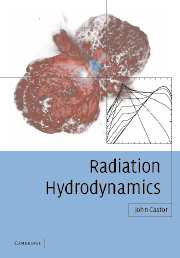Book contents
- Frontmatter
- Contents
- List of figures
- Preface
- 1 Introduction
- 2 A quick review of gas dynamics
- 3 Numerical hydrodynamics
- 4 Description of radiation
- 5 Steady-state transfer
- 6 The comoving-frame picture
- 7 Hydrodynamics with radiation: waves and stability
- 8 Radiation–matter interactions
- 9 Spectral line transport
- 10 Refraction and polarized light
- 11 Numerical techniques for radiation transport
- 12 Examples
- References
- Index
3 - Numerical hydrodynamics
Published online by Cambridge University Press: 18 February 2010
- Frontmatter
- Contents
- List of figures
- Preface
- 1 Introduction
- 2 A quick review of gas dynamics
- 3 Numerical hydrodynamics
- 4 Description of radiation
- 5 Steady-state transfer
- 6 The comoving-frame picture
- 7 Hydrodynamics with radiation: waves and stability
- 8 Radiation–matter interactions
- 9 Spectral line transport
- 10 Refraction and polarized light
- 11 Numerical techniques for radiation transport
- 12 Examples
- References
- Index
Summary
In Chapter 2 we have already discussed the Eulerian and Lagrangian formulations of the equations of fluid mechanics. Now we want to describe some of the numerical solution methods that have been developed to solve them, and in particular, in the more challenging 2–D and 3–D cases. The present discussion will focus on hydrodynamics without radiation, and the methods for treating coupled hydrodynamics and radiation will be mentioned later, in Chapter 11.
There are excellent references on this subject, among which are the classic book by Richtmyer and Morton (1967), the text by Bowers and Wilson (1991), the collection of papers by Norman and coworkers (Stone and Norman, 1992a,b; Stone, Mihalas and Norman, 1992), van Leer (1979), Colella and Woodward (1984), Caramana and coworkers (Caramana and Whalen, 1998; Caramana and Shashkov, 1998; Caramana, Shashkov, and Whalen, 1998; Caramana, Burton, Shashkov, and Whalen, 1998) and Jiang and Shu (1996).
Lagrangian methods
Staggered-mesh hydrodynamics for 1-D slab geometry
The mother of all numerical hydrodynamics methods has the name von Neumann–Richtmyer staggered-mesh hydrodynamics. In its simplest incarnation, for 1-D slab geometry, it is described as follows. The material of the problem is divided into N zones with fixed masses, divided by N – 1 material interfaces. Including the outer boundaries, that makes N + 1 interfaces in all. The basic set of unknowns is the list of z coordinates of these interfaces: zI, I = 1, …, N + 1. Time is discretized as well, and these interface positions are to be found at a succession of times: t1, t2, …. The position of interface I at time t = tn is denoted by znI.
- Type
- Chapter
- Information
- Radiation Hydrodynamics , pp. 41 - 68Publisher: Cambridge University PressPrint publication year: 2004

